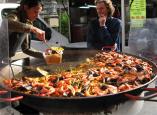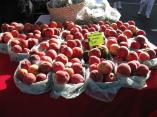I’ve yet to get my hands on a copy of Harold McGee‘s latest book, Nose Dive: A Field Guide to the World’s Smells, but I revere his classic work, On Food and Cooking: The Science and Lore of the Kitchen. And was delighted to catch his talk at last summer’s Oxford Symposium on Food & Cookery... That conference truly was one of the highlights of my year. A sincere thank you to pandemic lockdown which made it possible to attend, and even greater thanks to the Symposium organizers who demonstrated, with deceptive ease, how to run a warm and friendly event, attended by hundreds of food lovers from all points of the compass.
Since then, Symposiasts have been attending Kitchen Table discussions on many and various topics. Today’s theme was Smells Nasty and Nice: How they guide us in the kitchen and at the table. McGee was in conversation with food writer Fuschia Dunlop, and around 200 of us gathered round our Zoom screens to hear what they had to say, filling the Chat with the observations, quotes, questions, recommendations and the same passionately informed and good-natured banter that featured in the Symposium.

McGee enchanted us with language: the “osmocosm” is probably going to be our favourite word for a while.. encompassing geology, biology, human culture: the idea that where you live provides its own aromatic microspace. The smell of eucalyptus in San Francisco.. volcanic emissions in Hawaii.. the smell of the sea, and underlying notes of cedar used to welcome me off the plane when I’d return to Victoria.
Anosmia was a popular topic, since loss of smell (and taste) is so often a symptom of COVID-19 infection, but it can also signal other viral infections, and the sense of smell declines with age. McGee said he’d experienced anosmia a couple of times – including one bout while writing this book! – and that it greatly affected how he ate and cooked, and lived, since he stopped going out for meals as there was little point if he couldn’t taste the food.
Some smells are culturally defined – Dunlop, an expert in Chinese cuisine, described the concept of a ‘fishy’ smell in raw meat (Xīng wèi according to google translate), which is dealt with by specific preparation methods. though smell receptors are to some extent genetically determined, many smells are also contextual: such as a foul odour that followed Dunlop around town, before she realized she was carrying cheese bought earlier from Neal’s Yard Dairy (surely one of the most aromatic establishments in London). Foul became fair as she anticipated the meal to come.
A question about why out of season tomatoes don’t smell or taste of anything, and whether aroma is tied to nutrition, elicited what I am sure is a greatly simplified answer: aroma molecules in plant materials like fruits and grains are made in the course of making other molecules in the plants. Plants have limited resources in making those molecules, so having time to ripen fully will optimize the taste, texture, aroma and nutritional qualities (vitamin A in the case of the tomato). A particularly strong aroma may in fact occur at the expense of other aspects, like taste and nutrition. Growing a fruit (such as a commercial tomato) as fast and heavy as possible, pumped up with water, means all molecular pathways are being depleted, in which case a lack of scent will correlate with lack of nutrients.
Molecules are really McGee’s bread and butter. The book includes a number of tables, he said, that show molecular correlations between otherwise different foods, e.g. cucumbers and oysters. These tables show what chemists have uncovered that explain why two foods have similar aroma notes (but different intensities. A 2.5 year old Parmigiano-Reggiano cheese develops an aroma like pineapple – why those resonances exist is why the book came about. Even toxic chemicals, which in larger quantities warn us off eating a food, can, in tiny amounts in the background, add an enjoyable flavour; for example notes of ammonia are present in ripe camembert, but in over-ripe camembert the ammonia overwhelms – so if the chemicals are excessive, we know to avoid the food.
The book covers far more than cooking, but cooking came up a lot in the discussion, like the idea that cooks monitor their dishes through smell (this one does it by sound!) – a kind of aromatic index of the transformation from raw to cooked. But, said McGee, really most of us start at the beginning, a quality test: we sniff anything we start cooking with – nuts (so often rancid), meats, dairy – to see what shape it’s in before they start.









